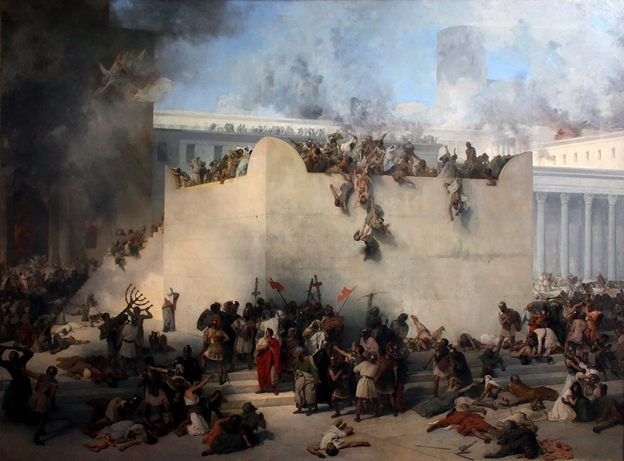
What is the Abomination of Desolation?
Jesus said some pretty interesting things. He did not mind shocking his audience. After meeting a wealthy, respected, religious seeker, Jesus said, “Again I tell you, it is easier for a camel to go through the eye of a needle than for a rich person to enter the kingdom of God,” (Matthew 19:24). The disciples were so perplexed at this statement they asked in astonishment, “Who then can be saved?” (Matthew 19:25). Earlier, when some kind friends brought a crippled man to Jesus, Jesus looked at the man and declared, “Take heart, my son; your sins are forgiven,” (Matthew 9:2). The religious leaders murmured, “This man is blaspheming,” (Matthew 9:3). Suffice to say that Jesus does not mind saying some things that are at least interesting and sometimes perplexing.
So, what does Jesus mean when He says, “When you see the abomination of desolation spoken of by the prophet Daniel, standing in the holy place (let the reader understand), then let those who are in Judea flee to the mountains,” (Matthew 24:15-16)?
First, let’s look to the context of Matthew 24. Jesus is leaving the temple for the last time. He will not return until His second coming to judge the living and the dead and to establish the new heavens and new earth. By then, the temple will be destroyed. As Jesus is leaving, the disciples point out the beautiful architecture. Jesus responds, “You see all these, do you not? Truly, I say to you, there will not be left here one stone upon another that will not be thrown down,” (Matthew 24:2). That’s like someone touring Washington, D.C. with a renowned teacher who looks at the white house and says, “Soon, not one brick will be left unbroken.” What, Jesus? It’s little wonder the disciples quickly asked, “Tell us, when will these things be?” (Matthew 9:3). So, the context for Jesus’s curious statement about the abomination of desolation is answering His disciples’ question about when the temple would be destroyed.
Now, it’s time for some history. Nero was adopted by the Emperor, Claudius, when Claudius married his mother, Agrippina after Nero’s father died. When Nero came to power, his mother used her influence to reign through her son, but Nero soon had her executed. He would also later kill his wife, Octavia. As emperor, Nero left much of the ruling of the Roman empire to prefects of the Praetorian Guard, like Afranius Burrus and to capable senators like Seneca. However, after Burrus’ death, Nero ruled more directly and proclaimed himself the savior of the world. In 64 A.D., a fire burned much of Rome, and Nero needed someone to blame, so he chose to blame the fire on Christians. It is likely that both Peter and Paul were executed in the widespread persecution that followed Nero’s false claims of Christian arson. Elsewhere in 66 A.D., a revolt erupted in Caesarea (which included Judea). Nero sent general Vespasian to end the revolt. Before the revolt could be fully dealt with, however, Emperor Nero’s ego was badly bruised by opposition from district governors. In 68 A.D., Emperor Nero committed suicide. Meanwhile, Vespasian was successfully leading the Roman army against the revolutionaries. Vespasian left the army in the hands of his capable son, Titus, and returned to Rome to seize control. He was appointed emperor in 69 A.D. and ruled for 10 years. With the army under his control, Titus led the Roman army to completely subdue the revolt in Palestine. On September 26, 70 A.D., Rome invaded Jerusalem, killed thousands of Jews, and burned the Temple of Jerusalem so that it was completely destroyed. Later in Rome, the Arch of Titus was built to show off the victory (Baker Encyclopedia of the Bible, 1:392-397). The awful and terrifying destruction of Jerusalem was painted by Francesco Hayez in 1867.
So, let’s review. We know at this point that in the context Jesus is teaching the disciples about when the temple would be destroyed. We also now know that the temple in Jerusalem was destroyed by Rome in 70 A.D. Jesus was in part warning the disciples (and later Christians) to be ready to flee to the mountains when Rome invaded Palestine. In fact, that’s exactly the way the passage reads in the Gospel of Luke, tailored to a more Gentile audience: “When you see Jerusalem surrounded by armies, then know that its desolation has come near. Then let those who are in Judea flee to the mountains,” (Luke 21:20-21). Jesus was helping Christians know when to run for their lives!
But there’s more to Jesus’s phrase, “the abomination of desolation” in Matthew 24:15. Jesus next mentioned that this idea was “spoken of by the prophet Daniel.” The Old Testament prophet, Daniel, was a Jewish exile who lived through an incredible time in Jewish history. He was taken captive by the Babylonians when they invaded Jerusalem. The Babylonians eventually destroyed Jerusalem in 587 B.C. Daniel was appointed as an advisor to the king and rose through the ranks to be one of Nebuchadnezzar’s most trusted advisors and wise men. Daniel was used by God to prophesy three times about future terribly pagan things that would happen to the temple in Jerusalem. Now, before these things could occur, the temple would have to be rebuilt by those exiles who returned to Jerusalem (see the books of Ezra and Nehemiah). In Daniel 9:27, he revealed that “on the wing of abominations shall come one who makes desolate,” and then in Daniel 11:31, “Forces from him shall appear and profane the temple and fortress, and shall take away the regular burnt offering. And they shall set up the abomination that makes desolate,” and finally in Daniel 12:11 he speaks again of the end of the burnt offering and the abomination that makes desolate. These are likely the verses to which Jesus referred. But, I get it, at this point you’re like, “But what in the world is Daniel talking about?” Stay with me!
Daniel was used by God to prophesy about kingdoms to come. After Babylon would come Persia. After Persia would come Greece. After Greece would come Rome. So precise were Daniel’s prophesies that many have claimed he had to have lived as late at shortly before Rome’s arrival in 63 A.D. Why? Because (they think) no prophesy is that good! But, a prophet is only as good as the God for whom He speaks, and Daniel spoke for the Lord Almighty. So this prophet was that good!
We know that after Alexander the Great conquered a vast territory to establish the Greek empire, the young conqueror suddenly died and his territories were divided amongst his generals: Seleucus in the east, Ptolemy to the south in Egypt and Antigonus, Cassander and Lysimachus in the north. For our purposes Ptolemy and Seleucus matter most. Jerusalem oscillated from being controlled by the Ptolemies to being controlled by the Selucids. By 167 B.C., the Seleucids controlled Jerusalem, and the fourth ruler, Antiochus IV (nicknamed Ephiphanes) came to power. Antiochus was hated by the Jews because he pushed Greek culture on them heavily. Tensions reached a head when Antiochus set up a pagan image to Zeus in the temple and sacrificed a pig on the altar. Shortly afterwards, the Jews revolted, led by an old priest (Mattathias) and his sons. One of those sons, Judas was given the nickname “the hammer” or Maccabee. Thus, the Maccabean revolt succeeded in retaking the temple in Jerusalem in 164 B.C. and the temple had to be thoroughly cleansed (ESV Study Bible, Notes on Daniel, 1604-1618).
Is a little daylight starting to creep in? The phrases in Daniel initially point to a wicked and ungodly ruler, like Antiochus IV who so profaned God’s holy place (the temple with a pig sacrificed on the altar) that God’s holy people had to vacate and could not use the temple to worship. Jesus co-opts the phrase to point to another time when God’s holy place would be profaned such that God and His people could not worship Him from Jerusalem.
So what profaning of the temple occurred shortly before the Roman armies arrived that signaled to the Christians in Jerusalem it was time to flee? This is actually rather difficult to say for sure. It may be that this specific fulfillment happened when zealots profaned the temple in A.D. 67-68, shortly before the fall of Jerusalem, but this is uncertain. However, it is clear that Jesus was compassionately warning Christians to be ready to flee when the temple was again profaned shortly before the Roman armies arrived. Thus, “the abomination of desolation” is a phrase that means a terrible pagan defiling of God’s holy place shortly before God’s people are attacked. One writer helpfully put it like this, “the enigmatic phrase symbolized an appalling and complete devastation of the sanctity of the temple,” (Baker Encyclopedia of the Bible, 1:10-11).
Why does this matter? Well let’s go back to the disciples’ initial question and read the whole verse: “Tell us, when will these things be, and what will be the sign of your coming and of the close of the age?” (Matthew 24:3). They thought they asked one question: When will the temple be destroyed / you return / the end be? We know that the end did not occur in 70 A.D., so not all of Jesus’s words in Matthew 24 have been fulfilled. We await His return when “as the lightning comes from the east and shines as far as the west, so will be the coming of the Son of Man,” (Matthew 4:27). Understanding tough phrases like “the abomination of desolation” matters because we want to be ready for His return, and one way we are ready is to learn from Jesus. What happened in 70 A.D. was not the total fulfillment of Jesus’s words. Christians should expect an extremely heightened time of pagan, blasphemous activity before the imminent return of Jesus.
So, Christian study on, pray on, and prepare yourself for when many will mock God.

